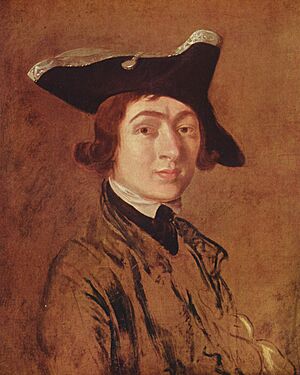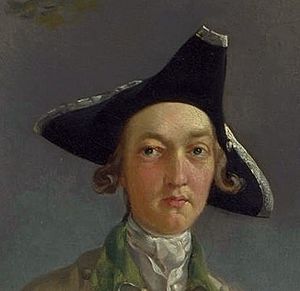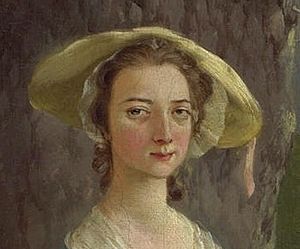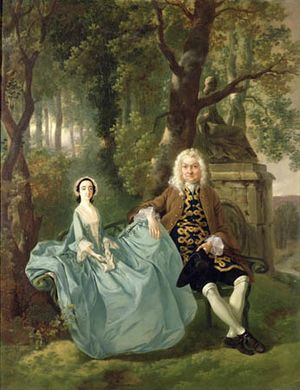Mr and Mrs Andrews facts for kids
Quick facts for kids Mr and Mrs Andrews |
|
|---|---|
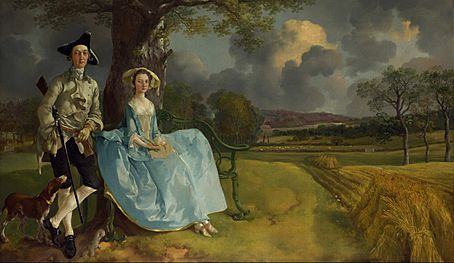 |
|
| Artist | Thomas Gainsborough |
| Year | c. 1750 |
| Medium | Oil on canvas |
| Dimensions | 69.8 cm × 119.4 cm (27.5 in × 47.0 in) |
| Location | National Gallery, London |
Mr and Mrs Andrews is a famous painting created around 1750 by the artist Thomas Gainsborough. It's an oil on canvas portrait that you can see today at the National Gallery, London.
This painting shows a recently married couple, Robert and Frances Andrews, in the English countryside. It's special because it combines two types of art: a portrait of people and a landscape showing nature. Gainsborough was known for both portraits and landscapes, but it was very rare for him, or other artists, to combine them in such a wide, horizontal painting. For many years, the painting stayed with the Andrews family and wasn't well known. But after it was shown in an exhibition in Ipswich in 1927, people started to love it. It became very popular and is now one of Gainsborough's most famous works.
Contents
About the Artist
Thomas Gainsborough was about 23 years old when he painted Mr and Mrs Andrews in 1750. He had learned art in London from a French artist named Hubert-François Gravelot, who taught him the rococo style. This style often used fancy, curvy designs and light colors. Gainsborough also loved painting landscapes, especially in the style of Dutch artists.
He returned to his hometown of Sudbury, Suffolk, which was also where the Andrews family lived. Even though he loved landscapes, painting portraits paid much better. He often joked that he was forced to "face paint" (paint portraits) instead of focusing on landscapes.
Mr and Mrs Andrews has the largest landscape background of all his portraits. After this painting, Gainsborough usually painted portraits with simpler backgrounds. Some people think he wanted to show off his landscape skills to get more clients, or maybe the Andrews family specifically asked for it.
This painting is relatively small, about 69.8 cm (2 feet 3 inches) high. This size was typical for Gainsborough's early portraits and landscapes. Later, when he painted for richer clients in London, his portraits became much larger, almost life-size. His landscape backgrounds usually showed woods, but this painting shows an open farmland view, which is quite unusual.
Gainsborough, like most artists of his time, didn't paint outdoors. So, Mrs. Andrews didn't actually pose in her silk clothes in the middle of the field! The landscape was painted in the studio, possibly based on sketches.
Meet the Sitters and Their Home
Robert Andrews was part of the landed gentry, which means his family owned a lot of land and were quite wealthy. His father was a landlord and also lent money to other important families. Robert was born in Bulmer, Essex in 1725. He went to school with Gainsborough in Sudbury and later attended University College, Oxford.
Robert's father bought him an estate and helped him find a wife to help him become even more connected to the upper classes. By 1750, Robert owned nearly 3,000 acres of land, including most of the land you can see in the painting. He took over the family business after his father passed away in 1763.
His wife is Frances Mary Carter. She grew up in the same area as Robert. They were married in Sudbury on November 10, 1748. Robert was 22, and Frances was 16. Her family also owned businesses and property. They had made their money in the fabric business.
The Andrews' estate, called Auberies, was in Bulmer Tye, not far from Sudbury. It was probably part of Frances's dowry (money or property a bride brings to a marriage) or bought with it. The small church you can see in the middle of the painting is All Saints, Sudbury, where they were married. The tower in the background on the left belongs to Holy Trinity Church in Long Melford. On the right, you can see the barns of the farm from Frances's childhood home. It was unusual for Gainsborough to paint such an accurate and identifiable location, so the couple likely asked for it. Their own house, Auberies, would have been behind the viewer, closer than the painting suggests.
Robert and Frances had nine children. Frances passed away at 48 in 1780, and Robert remarried. He lived to be 80, passing away in 1806. They are buried in the churchyard of St. Andrew's Church in Bulmer.
The couple's clothes show they are dressed quite informally for their time and position. Robert wears a loose hunting coat with bags for gunpowder and shot. Frances wears a light blue summer outfit, which might not have been her actual clothing color, as Gainsborough often used this shade for his early female portraits. She wears comfortable mules and a straw hat. However, their poses are different: Robert looks relaxed, while Frances sits very straight. Her figure was likely painted from a dressed artist's mannequin. The fancy bench she sits on was probably invented by Gainsborough, inspired by his time with Gravelot.
Gainsborough had also painted Frances's parents, Mr. and Mrs. Carter, a few years before. This earlier painting is interesting to compare with Mr and Mrs Andrews.
The neat rows of corn in the painting show that this was a modern and efficient farm. This was thanks to the seed drill, a new farming tool invented by Jethro Tull. Robert Andrews was very interested in farming. He even wrote a letter about wheat that was published in an agriculture magazine. These farming details are not typical of Gainsborough's landscapes, so it's likely Robert Andrews asked for them to be included. The wheat field is actually shown much closer to the house than it would have been in real life.
The large oak tree in front of which the Andrews stand is also important. Oak trees often represent Englishness, strength, and the idea of family businesses continuing through generations. This specific oak tree still stands today, much larger than it was in the painting.
What's Missing?
There's a small area on Mrs. Andrews' lap that isn't fully painted. It looks like a space was left for something. Many people think a cock pheasant (a type of bird) was meant to be there, but the painting seems to be set before pheasant hunting season.
Other ideas for what might have been painted there include a work bag for embroidery, a book, a fan, a lapdog, or even a baby. The Andrews' first child, a daughter, was born in 1751, a year after the painting was made.
Painting's Journey Through Time
After being "rediscovered" at an exhibition in Ipswich in 1927, Mr and Mrs Andrews became very popular. It was shown in many exhibitions across Britain and Europe, including Brussels, London, Amsterdam, and Paris. After World War II, it continued to travel, being shown in places like Norwich, Paris (for Queen Elizabeth II's Coronation in 1953), and even Fort Worth, Texas.
The painting stayed with the Andrews family until 1960. That year, a descendant of the sitters sold it at an auction in London. The National Gallery bought it for £130,000, which was a large sum at the time. It was purchased with help from various grants and contributions. The painting is still in excellent condition today, except for the small unpainted area mentioned earlier.
See also
 In Spanish: Señor y señora Andrews para niños
In Spanish: Señor y señora Andrews para niños
- 100 Great Paintings, 1980 BBC series


